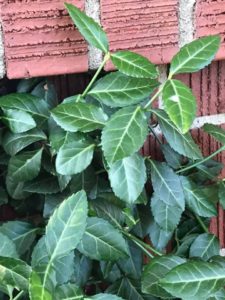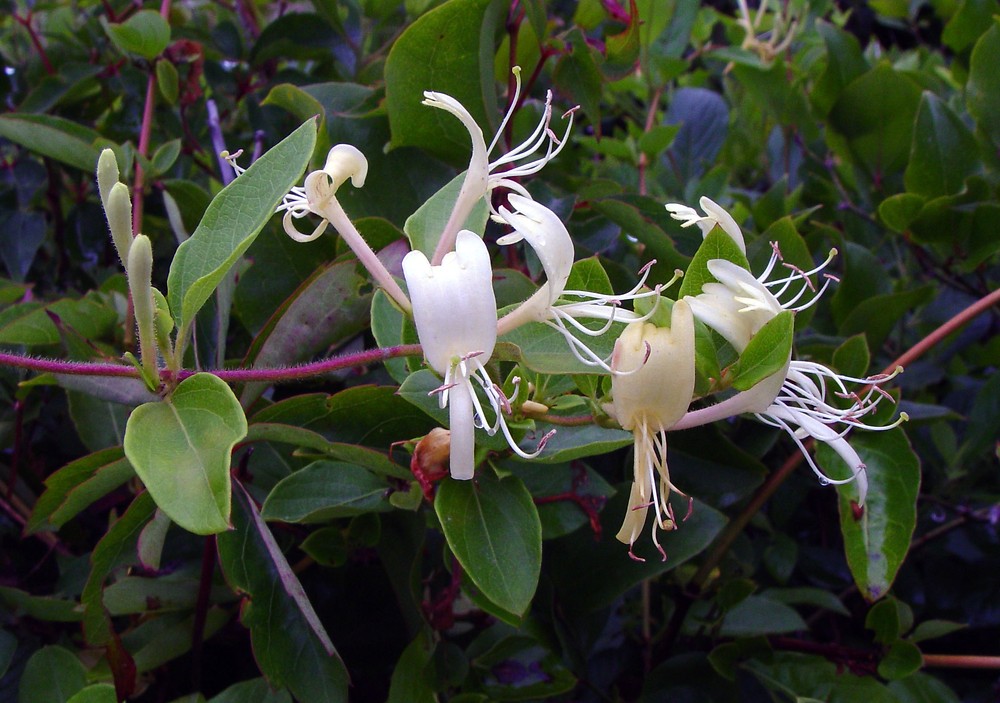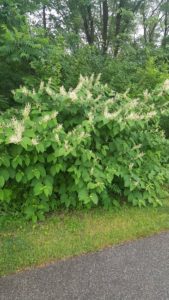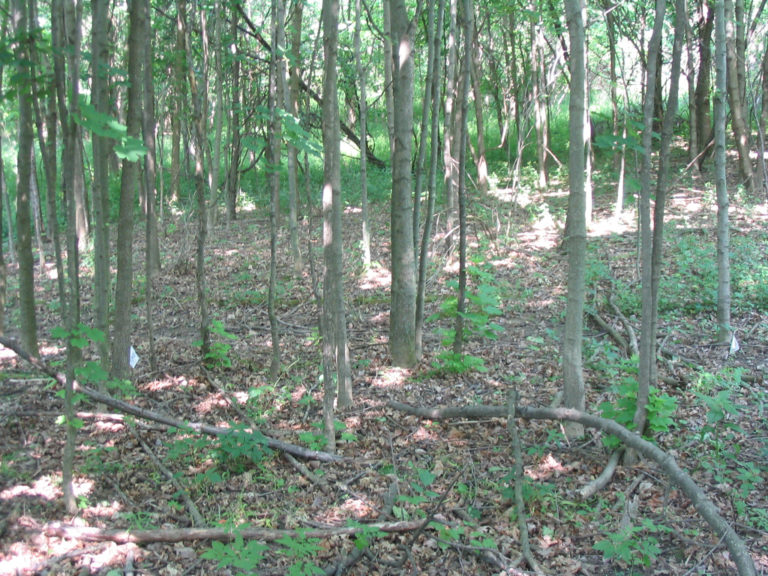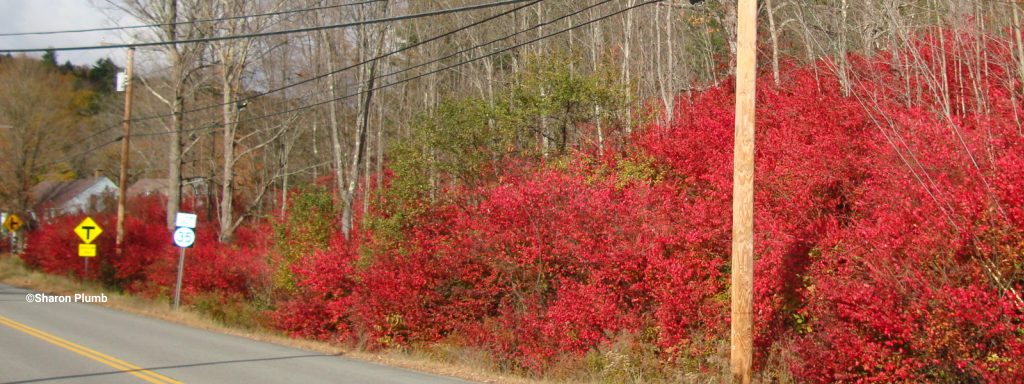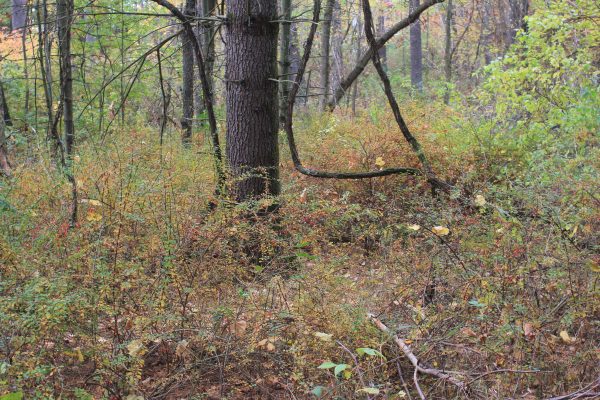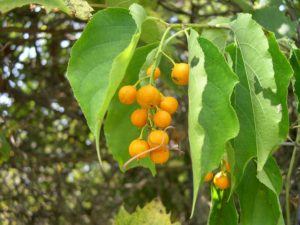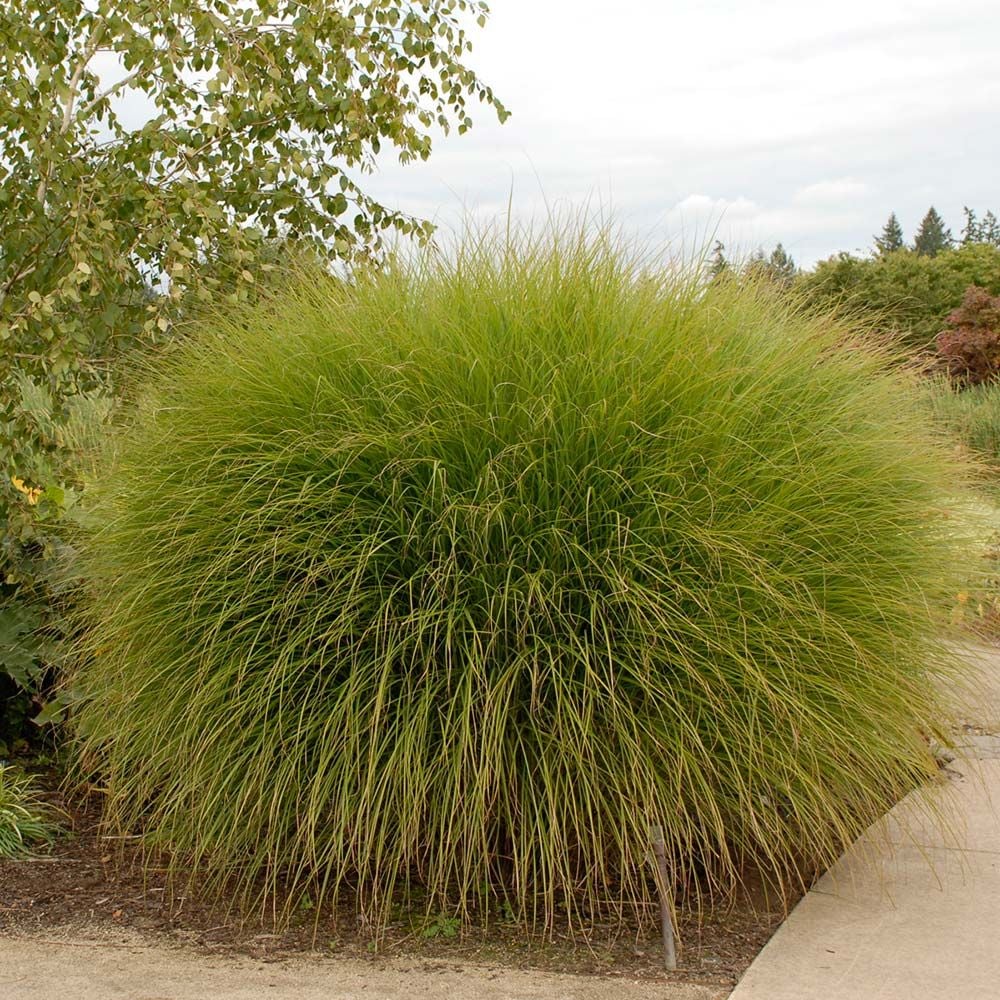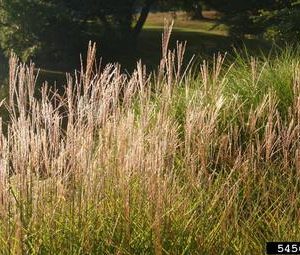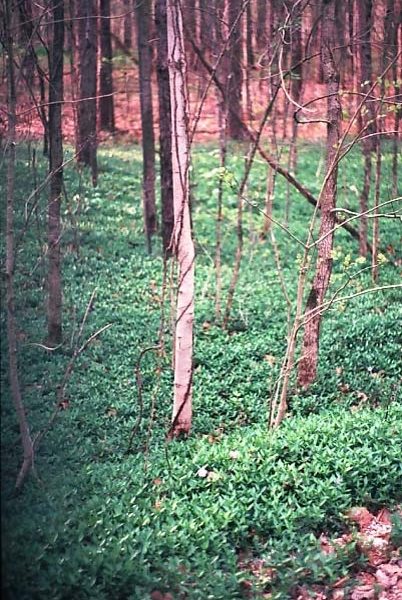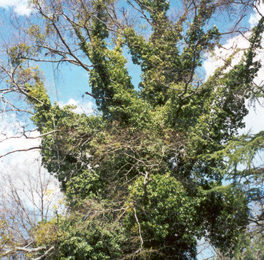Some commonly sold landscaping plants are invasive, and although a few are now prohibited under the Indiana Invasive Terrestrial Plant Rule, you may find some for sale or already planted in your yard. Here are fifteen to do without, and some suggested native alternatives.
Asian Bush Honeysuckle
(Lonicera maackii, L. morrowii,
L. tatarica, L. x bella)
Status: Common invasive plant throughout Indiana, sold for landscaping and wildlife plantings. Prohibited Invasive Terrestrial Plant [312 IAC 18-3-25]
Description: These upright shrubs with arching branches are 6-15 feet tall. Each of these species has dark green egg-shaped leaves. They stand out in the understory of forests as the first shrubs to leaf out in the spring and the last to lose leaves in the fall. The paired, tubular flowers are white on Amur and Morrow honeysuckle and pink on Tatarian honeysuckle. Berries range from red to orange and are dispersed by birds.
Threat: Rapidly forms a dense shrub layer that excludes native understory shrubs, decreases species richness, reduces canopy tree growth, increases ticks and tick-related illnesses.
Native Alternatives: Grey dogwood (Cornus racemosa), silky dogwood (C. amomum), redosier dogwood (C. sericea), black chokeberry (Aronia melanocarpa), winterberry (Ilex verticillata), southern arrowwood (Viburnum dentatum).
Wintercreeper
(Euonymus fortunei)
Status: Common invasive in Indiana, especially in and near urban areas; widely sold as a landscaping groundcover. Prohibited Invasive Terrestrial Plant [312 IAC 18-3-25]
Description: Evergreen, clinging vine. Can form a dense ground cover or shrub to 3 feet in height, or climb 40‐70 foot high vertical surfaces with the aid of aerial roots. Stems are narrow, minutely warty, and have abundant rootlets or trailing roots. Leaves are dark green, shiny, and egg-shaped, from 1‐2 ½ inches long, with toothed margins and silvery veins, occur in pairs along the stems. Clusters of inconspicuous green-white flowers are produced on a long stalk in mid‐summer and are followed in the autumn by pinkish to red capsules that split open to expose seeds adorned with a fleshy orange seed coat, or aril.
Threat: Outcompetes native vegetation by depleting soil moisture and nutrients, blocking sunlight, and by forming a dense vegetative mat that impedes the growth of seedlings of native species. Vines on trees continue climbing and can eventually overtop them, covering the leaves and preventing photosynthesis.
Native Alternatives: Wild ginger (Asarum canadense), Allegheny spurge (Pachysandra procumbens), golden ragwort (Packera aurea)
Japanese Honeysuckle
(Lonicera japonica)
Status: Common invasive in southern and central Indiana, aka Hall’s honeysuckle, sold as a trellis vine and for deer forage. Prohibited Invasive Terrestrial Plant [312 IAC 18-3-25]
Description: Perennial, semi‐evergreen, woody vine. Young stems brown or red and usually pubescent; older stems woody and hollow. Leaves simple, opposite, oblong to oval, 1.5‐3” long, sometimes lobed, and may be covered with fine, soft hairs. Leaves persist on vine until mid‐winter. Flowers tubular and very fragrant, white to pink, turning yellow with age, and occurring in pairs at leaf axils. Blooms late spring to early summer. Purple to black berries produced in fall.
Threat: Grows over native vegetation, robbing it of light; can kill shrubs and young trees by girdling when vines twist tightly around stems.
Native Alternatives: Virginia creeper (Parthenocissus quinquefolia), virgin’s bower (Clematis virginiana), American bittersweet (Celastrus scandens).
Japanese Knotweed
(Reynoutria japonica, syn. Fallopia japonica, Polygonum cuspidatum)
Status: Invasive species found in most counties, sold for landscaping, especially as a hedge plant. Prohibited Invasive Terrestrial Plant [312 IAC 18-3-25]
Description: Arching herbaceous perennial, up to 10’ tall. Hollow, reddish, bamboo-like stems are smooth and stout, often persisting after plant dies back to the ground each year. Leaves alternate, egg‐shaped to almost triangular, 4‐6” long, 3‐4” wide. Dark green on upper surface, pale green on lower surface. Branched inflorescences of tiny, creamy white or greenish flowers emerge from leaf axils near the ends of stems. Blooms in late summer. Fruits are small, winged, and triangular with very small, shiny seeds.
Threat: spreads vegetatively to form dense thickets that suppress other vegetation in upland and lowland areas; can dominate along creeks, which leads to increased bank shear and erosion; decreases habitat for wildlife; rhizomes can damage building foundations and other structures.
Native Alternatives: Nannyberry (Viburnum lentago), goatsbeard (Aruncus dioicus), redosier dogwood (Cornus sericea).
Privet
(Ligustrum obtusifolium, L. vulgare)
Status: Common invasive species along creeks and rivers throughout the state; commonly sold for hedge plantings. Prohibited Invasive Terrestrial Plant [312 IAC 18-3-25]

Courtesy Donna Meidinger
Description: Shrub to 12 feet tall; leaves opposite, nearly stalkless, elliptic to oblong with a tapering base and blunt tip, may be hairy on underside; flowers small, white, and tubular with 4 spreading petals in terminal racemes; flower tube is 2-3 times as long as lobes; fruit is black berry. Woodland Stewardship for Landowners: Privet
Threat: Forms dense stands that displace native species.
Native Alternatives: Grey dogwood (Cornus racemosa), silky dogwood (C. amomum), redosier dogwood (C. sericea), black chokeberry (Aronia melanocarpa), winterberry (Ilex verticillata), southern arrowwood (Viburnum dentatum).
Callery Pear
(Pyrus calleryana)
Status: Rapidly invading roadsides and forests across the state; one of the most widely sold landscaping trees in the eastern U.S.

Courtesy the Grumpy Gardener, Southern Living.
Description: Deciduous tree to 30 feet tall; leaves alternate, ovate, smooth, finely toothed and wavy edged, shiny green above and paler below; flowers white, 5 petals, in dense clusters, unpleasant odor; small, round, brown fruits.
Threat: Produces large number of fruits which are spread by starlings; can establish densely in forest understory and outcompete native trees.
Native Alternatives: Serviceberry (Amelanchier laevis and A. arborea), redbud (Cercis canadensis), American hornbeam (Carpinus caroliniana), hop hornbeam (Ostrya virginiana), pagoda dogwood (Cornus alternifolia).
Norway Maple
(Acer platanoides)
Status: Invading forests in northern Indiana; very popular yard tree.
Description: Deciduous tree; leaves opposite and palmate with 5-7 lobes, can be purple-leaved; widely spreading winged fruit; milky sap in petioles which are 3-4 inches long; gray bark.
Threat: Regenerates prolifically under forest canopy and displaces native trees, shrubs and herbs.
Native Alternatives: Red maple (Acer rubrum), sugar maple (Acer saccharum), Ohio buckeye, (Aesculus glabra), persimmon (Diospyros virginiana), swamp white oak (Quercus bicolor), shumard oak (Quercus shumardii).
Burning Bush
(Euonymus alatus)
Status: Invading forest understories throughout Indiana; very popular landscaping shrub for its bright red foliage in the fall.
Description: Deciduous shrub to 15 feet tall and wide; opposite leaves oval to obovate and finely toothed, 1-3 inches long and 1/2 to 1 1/4 inches wide, stalkless or nearly so; leaves turn bright red in
fall, pink in shade; green to brown stems often have 2-4 prominent corky wings; small green flowers with 4 petals.
Threat: Creates dense thickets in forest understory, displacing native plants.
Native Alternatives: Blackhaw (Viburnum prunifolium), highbush blueberry (Vaccinium corymbosum), red chokeberry (Aronia arbutifolia), winterberry (Ilex verticillata).
Japanese Barberry
(Berberis thunbergii)
Status: Found scattered in forest understories throughout the state; in northern Indiana dense infestations can be found in some forests. Prohibited Invasive Terrestrial Plant [312 IAC 18-3-25]
Description: Shrub; leaves small, round to ovate, green or reddish purple, and in clusters around a spine; cross section of stem is bright yellow; yellow, umbrella-shaped flowers in clusters of 2-4; fruit small, pendant, bright red, and egg-shaped. Woodland Stewardship for Landowners: Japanese Barberry
Threat: Significantly increases tick populations and tick-borne illnesses; changes soil microbial community and nutrient cycling.
Native Alternatives: New Jersey tea (Ceanothus americanus), grey dogwood (Cornus racemosa), silky dogwood (C. amomum), redosier dogwood (C. sericea), black chokeberry (Aronia melanocarpa), winterberry (Ilex verticillata).
Asian Bittersweet
(Celastrus orbiculatus)
Status: Invading forests throughout Indiana, particularly in southeast Indiana and the dune communities of northwest Indiana; sold as a landscaping vine and as cut stems for wreaths. Prohibited Invasive Terrestrial Plant [312 IAC 18-3-25]
Description: Woody, deciduous, climbing vine; leaves alternate, ovate to round, abruptly sharp-pointed and glossy; small greenish flowers occur in clusters in the leaf axils; yellow, papery coat surrounding capsule splits to reveal red-orange fruit in leaf axils in fall.
Threat: Climbs up and overtops trees, making them more vulnerable to windthrow; hybridizes with native bittersweet, with the hybrids out-competing the native species.
Native Alternatives: Crossvine (Bignonia capreolata), American bittersweet (Celastrus americana) but be aware that sometimes the invasive species is mistakenly sold under an American Bittersweet label, virgin’s bower (Clematis virginiana).
Chinese Maiden Grass
(Miscanthus sinensis)
Status: Invading roadsides and old fields in southern Indiana; one of the most popular ornamental grasses sold.
Description: Perennial to 8 feet tall; long leaves have silver midrib; flower spikes 8-10 inches long, persist into winter as silvery plumes.
Threat: Spreads out of plantings, displacing native vegetation.
Native Alternatives: Prairie dropseed (Sporobolus heterolepsis), little bluestem (Schizachyrium scoparium), switchgrass (Panicum virgatum).
Periwinkle
(Vinca minor)
Status: Has invaded hundreds of acres of forest in southern Indiana.
Description: Woody, evergreen, trailing vine; leaves opposite, about 1 inch long, leathery, with entire margin; blue-purple flowers in early spring,five-lobed, solitary flowers in leaf axils.
Threat: Forms a dense layer on the forest floor which reduces tree seedling recruitment and may alter forest succession.
Native Alternatives: Virginia creeper (Parthenocissus quinquefolia), wild ginger (Asarum canadense), sedges (Carex spp.).
Sweet Autumn Clematis
(Clematis terniflora)
Status: Invading open areas in scattered counties across Indiana; popularly sold vine for trellises.
Description: Deciduous climbing vine; leaves opposite, pinnately compound, leaflets with smooth margins; flowers are white, borne in fall; fruits have fluffy masses of feather-like styles.
Threat: Climbs over and smothers other vegetation.
Native Alternatives: Trumpet honeysuckle (Lonicera sempervirens), virgin’s bower (Clematis virginiana).
English Ivy
(Hedera helix and H. hibernica)
Status: Invading forests in and near urban areas in Indiana.
Description: Evergreen, climbing vine; leaves alternate, dark green with white veins, waxy or leathery, shallowly to deeply lobed with 3-5 lobes; small yellow-green flowers and fleshy black-purple fruits produced when vine is allowed to climb.
Threat: Outcompetes native vegetation by depleting soil moisture and nutrients, blocking sunlight, and by forming a dense vegetative mat that impedes the growth of seedlings of native species. Vines on trees continue climbing and can eventually overtop them, covering the leaves and preventing photosynthesis.
Native Alternatives: Wild ginger (Asarum canadense), Allegheny spurge (Pachysandra procumbens), golden ragwort (Packera aurea)
Jetbead
(Rhodotypos scandens)
Status: Invading forests in a few areas of the state, usually near urban areas.
Description: Shrub to 15 feet tall; leaves opposite, simple, strongly toothed margin; flowers white and 2 inches wide, four petals; fruit 1-4 shiny black berries.
Threat: Can displace native shrubs and wildflowers in forests.
Native Alternatives: Silky dogwood (Cornus amomum), black chokeberry (Aronia melanocarpa), winterberry (Ilex verticillata), New Jersey tea (Ceanothus americanus).


